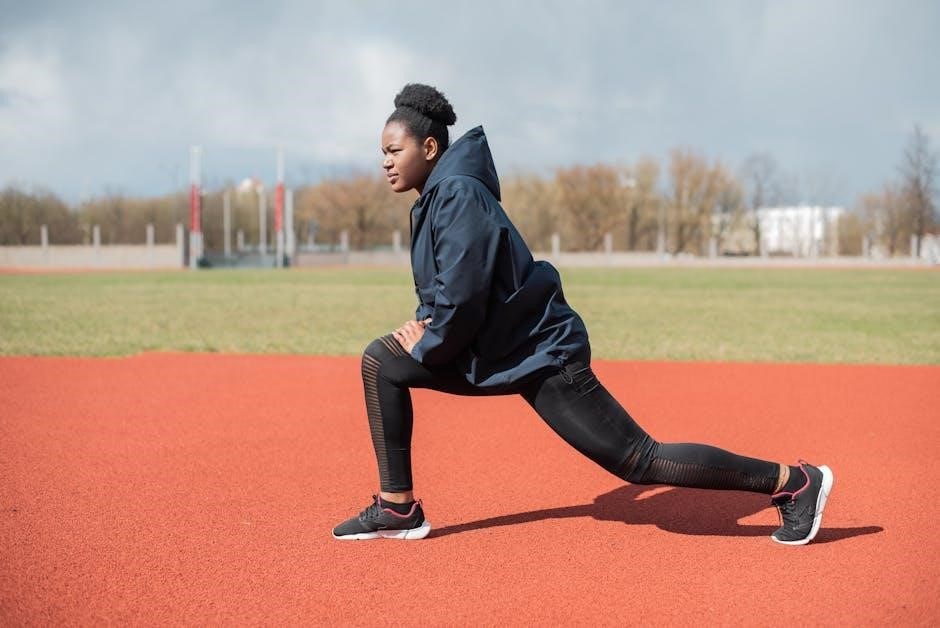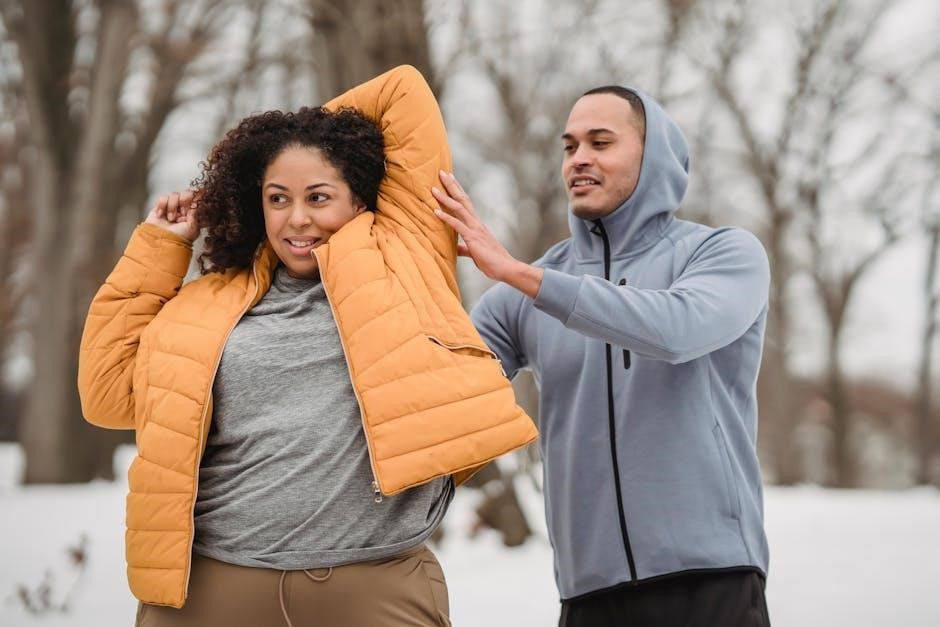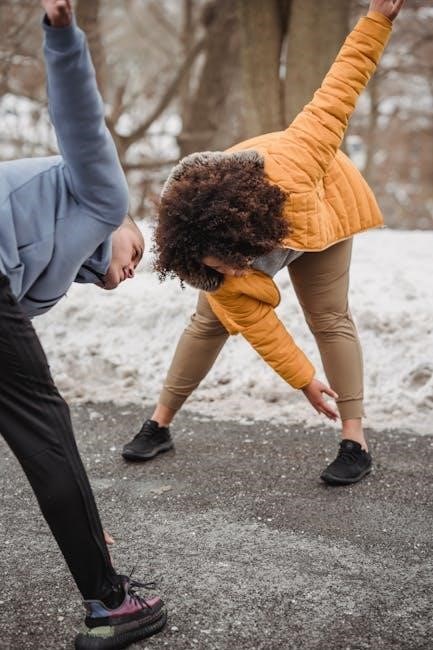jacket size guide
A well-fitting jacket enhances both style and comfort‚ making proper sizing essential. This guide helps navigate the complexities of jacket sizing‚ ensuring a perfect fit for every body type and preference.
1.1 Importance of Proper Jacket Sizing
Proper jacket sizing ensures comfort‚ mobility‚ and a polished appearance. A well-fitting jacket prevents restrictive movement and discomfort‚ while also enhancing confidence and style. Ill-fitting jackets can look unflattering and may lead to premature wear. Accurate sizing is crucial for both practicality and aesthetics‚ making it a cornerstone of wardrobe satisfaction. Investing time in finding the right fit ensures lasting enjoyment and versatility for various occasions.
1.2 Common Challenges in Finding the Right Jacket Size
Finding the perfect jacket size can be tricky due to inconsistent sizing across brands and styles. Measurements may vary slightly between manufacturers‚ making it difficult to rely solely on standard size charts. Additionally‚ differences in fabric thickness and intended fit (slim‚ regular‚ or oversized) can complicate the process. Online shoppers face the added challenge of not being able to try jackets on before purchase‚ increasing the risk of sizing mismatches despite careful measurements.

Understanding Jacket Measurements
Accurate jacket measurements are crucial for a perfect fit. They typically include chest‚ shoulder‚ sleeve‚ and length dimensions‚ ensuring the jacket aligns with your body proportions seamlessly.

2.1 Key Measurements for Jacket Sizing
Key measurements for jacket sizing include chest circumference‚ shoulder width‚ sleeve length‚ and overall jacket length. These dimensions ensure a tailored fit. Chest size is vital for comfort and mobility‚ while shoulder width determines how the jacket sits; Sleeve length should align with your wrist when arms are slightly bent. Jacket length typically ranges from hip to mid-thigh for standard styles. Accurate measurements are essential for selecting the right size‚ ensuring both comfort and style;
2.2 How to Measure Yourself Accurately
To measure yourself accurately‚ use a flexible tape measure. Wrap it around your chest‚ keeping the tape level and parallel to the floor. Ensure it’s snug but not overly tight. Measure your shoulder width from one tip to the other‚ and sleeve length from the back of your neck to your wrist. For jacket length‚ measure from the base of your neck to your desired hemline. Stand up straight and avoid slouching for precise results. A friend can assist for better accuracy.
2.3 Differences in Measurements Across Manufacturers
Different manufacturers often have varying size charts‚ making jacket sizing inconsistent. Some brands may cut jackets larger or smaller than standard measurements. Fabric thickness and intended fit (slim‚ regular‚ or oversized) can also affect how measurements translate to actual garment sizes. Always consult the specific brand’s size chart‚ as there may be discrepancies due to their unique cutting patterns and fit philosophies. This variation emphasizes the importance of measuring yourself accurately and comparing to the brand’s guidelines for the best fit.

Types of Jacket Fits
Jackets come in slim‚ regular‚ and oversized fits. Slim fits are tailored‚ regular offers a classic silhouette‚ and oversized provides a loose‚ casual look. Each offers unique style and comfort.
3.1 Slim Fit Jackets
Slim fit jackets are tailored to fit closely to the body‚ offering a modern‚ streamlined appearance. They are designed to skim the torso without restricting movement‚ ideal for those with a slim build or preferring a contemporary look. Unlike regular or oversized fits‚ slim jackets create a sharp‚ fashionable silhouette. They are best suited for casual or semi-formal occasions‚ pairing well with tailored trousers or jeans. To ensure the right fit‚ compare measurements with a shirt that fits you perfectly.
3.2 Regular Fit Jackets
Regular fit jackets offer a balanced‚ classic style that combines comfort and versatility. They are slightly roomier than slim-fit jackets‚ providing ease of movement while maintaining a clean appearance. Ideal for everyday wear‚ regular fit jackets suit most body types and are versatile enough for both casual and semi-formal occasions. They typically have a bit more room in the chest and shoulders compared to slim fits‚ making them a practical choice for those who prefer a relaxed yet tailored look.
3.3 Oversized Fit Jackets
Oversized fit jackets are designed to be roomy and comfortable‚ offering a loose‚ relaxed silhouette. They are intentionally larger than the wearer’s body‚ creating a stylish‚ casual look. These jackets often feature dropped shoulders and a longer length‚ providing a modern‚ edgy vibe. Ideal for layering over sweaters or dresses‚ oversized jackets are a versatile choice for those who prefer a bold‚ fashion-forward statement. They suit a variety of styles‚ from streetwear to high-fashion trends‚ making them a popular option for many wardrobes.
How to Choose the Right Jacket Size
Selecting the right jacket size involves measuring accurately‚ consulting size charts‚ and considering fit preferences. Ensure the jacket aligns with your body type and desired style for optimal comfort and appearance.
4.1 Using a Size Chart
A size chart is a crucial tool for determining the right jacket fit. It provides measurements corresponding to different sizes‚ helping you match your body dimensions accurately. Always compare your measurements to the chart‚ considering factors like fabric thickness and season. If unsure‚ refer to sizing feedback in reviews or use virtual size guides. Remember‚ sizes can vary across brands‚ so double-checking ensures the best fit. This method is reliable for both in-store and online shopping experiences‚ enhancing comfort and style.
4.2 Considering Fabric Thickness and Season
Fabric thickness and season significantly impact jacket sizing. Thicker materials‚ like wool or down‚ may require a larger size for comfort‚ while lighter fabrics‚ such as polyester‚ offer a snug fit. Seasonal jackets‚ like winter coats‚ often need extra room for layering‚ suggesting a slightly larger size. Conversely‚ summer jackets may fit true to size. Always check the size chart for fabric-specific measurements and consider seasonal adjustments to ensure the perfect balance of style and functionality.
4.3 How Activity Level Affects Fit
Your activity level plays a crucial role in determining the ideal jacket fit. For high-energy activities‚ opt for a jacket with a flexible‚ breathable design to accommodate movement. If you’re less active‚ a more tailored fit may be preferable. Consider the fabric’s moisture-wicking properties and ventilation features for active use. Ensure the jacket allows for a full range of motion without feeling restrictive‚ balancing comfort and functionality based on your lifestyle and needs.
Jacket Size Guide for Different Body Types
Find the perfect jacket fit based on your body type. Petite frames benefit from tailored styles‚ while athletic builds may prefer roomier designs. Broad shoulders require precise measurements for comfort and style.
5.1 Petite Body Type
Petite individuals often face challenges with jackets that are overly long or boxy. Opt for tailored‚ cropped styles to elongate the torso. Look for jackets with shorter sleeves and a fitted waist. Avoid bulky fabrics that can overwhelm a smaller frame. Consider lightweight materials and streamlined designs for a balanced look. Pay attention to shoulder fit‚ as drooping shoulders can exaggerate proportions. Use size charts to ensure accuracy‚ and don’t hesitate to explore petite-specific collections for the best results.
5.2 Athletic Build
For those with an athletic build‚ jackets should accommodate broader shoulders and a muscular torso. Opt for athletic-fit or tailored styles to maintain definition without restriction. Ensure the shoulder seams align perfectly to avoid a boxy appearance. Consider jackets with slight stretch for ease of movement. Longer jackets can help balance proportions‚ while high-tech fabrics like breathable or moisture-wicking materials enhance functionality. Always check size charts and reviews for fit feedback to ensure the best match for your physique.
5.3 Broad Shoulders or Larger Frame
Individuals with broad shoulders or a larger frame require jackets that provide both comfort and structure. Look for styles with reinforced shoulders and an extended fit to ensure a seamless drape. Relaxed or oversized fits can offer a more comfortable fit without appearing boxy. Consider layering options and adjustable features like cuffs or hem cinches to tailor the fit further. Always refer to size charts and reviews to ensure the jacket complements your frame effectively and provides optimal comfort.

Tips for Shopping Online
When shopping online‚ use size charts‚ customer reviews‚ and virtual fit tools to ensure the best fit. Check return policies for hassle-free exchanges or refunds.

6.1 Checking Reviews for Sizing Feedback
Reading customer reviews is crucial for sizing accuracy. Many shoppers share detailed feedback about fit‚ helping you gauge if a jacket runs small‚ large‚ or true to size. Pay attention to comments about specific measurements or body types‚ as they can provide insights into how the jacket fits various frames. This firsthand information can help you make informed decisions and avoid potential sizing mismatches. Use this feedback to adjust your size choice for a better fit.
6.2 Using Virtual Size Guides or Filters
Virtual size guides and filters are invaluable tools for online shopping. Many websites offer size recommendation features that use your measurements to suggest the best fit. Filters can narrow down options by size‚ fit‚ and even customer ratings. These tools reduce guesswork and enhance accuracy. By leveraging technology‚ you can make more informed decisions and find a jacket that fits perfectly without the need for in-person try-ons. This modern approach streamlines the shopping process and boosts confidence in your purchase.
6.3 Importance of Return Policies
Return policies are crucial when shopping for jackets online‚ as sizing can vary significantly between brands. A flexible return policy allows you to try the jacket without risk‚ ensuring the fit is perfect. Look for options that offer free returns or exchanges‚ reducing inconvenience and costs. Clear return policies build trust and minimize the hassle of finding the right size‚ making online shopping more confident and stress-free. This ensures satisfaction and encourages customers to explore different styles and fits.

Custom Tailoring Options
Custom tailoring offers a personalized fit‚ ensuring your jacket matches your unique measurements and style preferences. It provides high-quality materials and craftsmanship for a timeless‚ bespoke look.
7.1 Benefits of Tailored Jackets
Tailored jackets offer unmatched fit and comfort‚ crafted to your exact measurements. They ensure a flattering silhouette‚ enhance confidence‚ and provide durability with premium materials. Customization allows for personal style expression‚ making each piece unique. Tailored jackets also avoid common sizing issues‚ offering a perfect fit without compromise. Whether for formal events or everyday wear‚ a tailored jacket is an investment in quality and timeless fashion.
7.2 How to Work with a Tailor for the Perfect Fit

Working with a tailor requires clear communication and preparation. Bring a garment that fits well as a reference to ensure accuracy. Discuss your style preferences‚ fabric choices‚ and any specific details you desire. Multiple fittings may be needed to achieve the perfect fit. Be open to the tailor’s expertise but don’t hesitate to share your thoughts. Taking notes and asking questions can help clarify the process. This collaboration ensures a jacket tailored to your exact needs and preferences.
7.3 Cost Considerations for Custom Jackets
Custom jackets vary in cost based on fabric quality‚ design complexity‚ and tailor expertise. High-end materials and intricate details increase prices‚ while simpler designs may be more affordable. Budget accordingly‚ considering long-term durability and fit. Discuss cost expectations with your tailor upfront to avoid surprises. Balancing quality and budget ensures a satisfying investment in your bespoke jacket.
